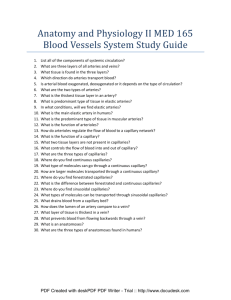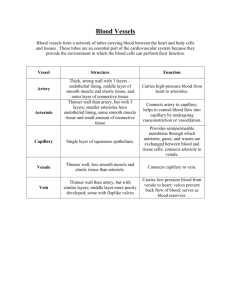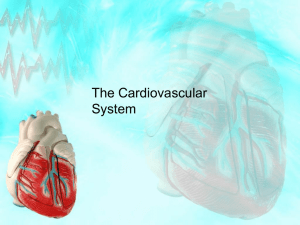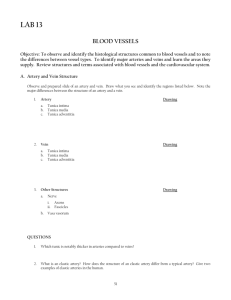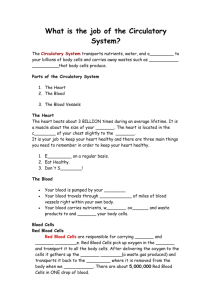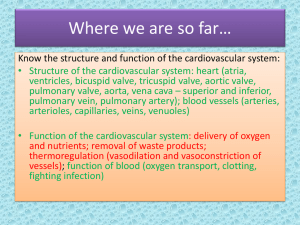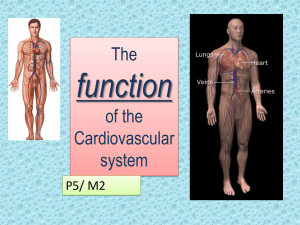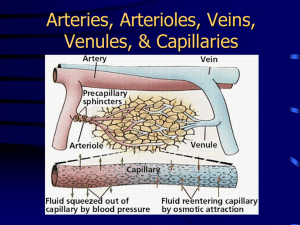Blood Vessels
advertisement
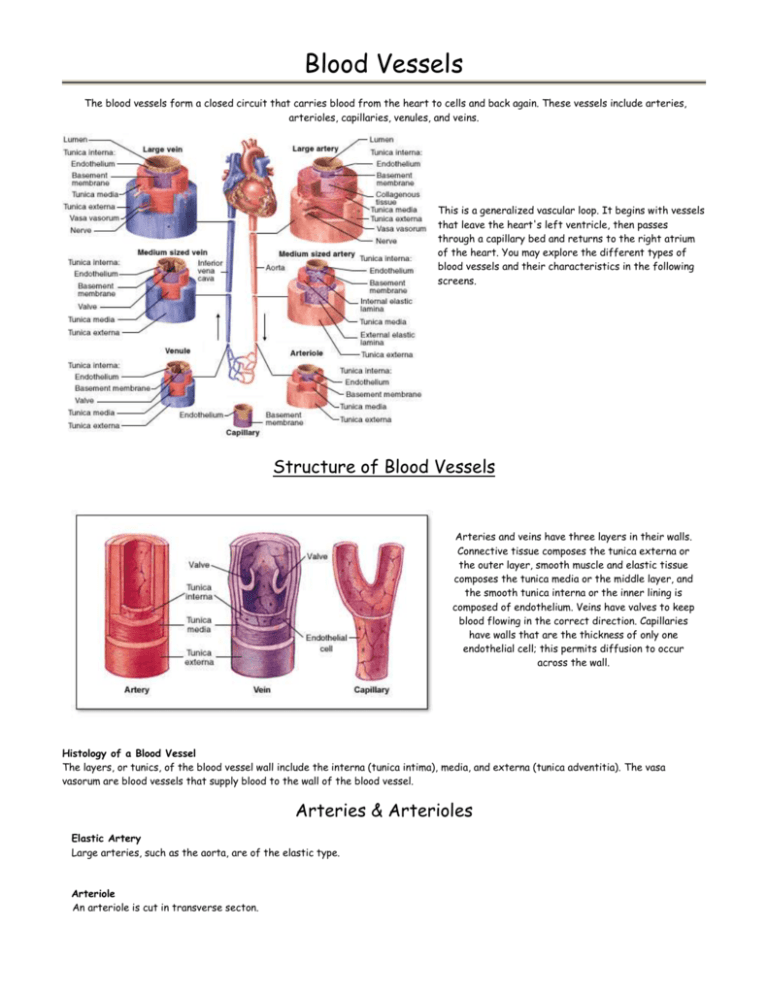
Blood Vessels The blood vessels form a closed circuit that carries blood from the heart to cells and back again. These vessels include arteries, arterioles, capillaries, venules, and veins. This is a generalized vascular loop. It begins with vessels that leave the heart's left ventricle, then passes through a capillary bed and returns to the right atrium of the heart. You may explore the different types of blood vessels and their characteristics in the following screens. Structure of Blood Vessels Arteries and veins have three layers in their walls. Connective tissue composes the tunica externa or the outer layer, smooth muscle and elastic tissue composes the tunica media or the middle layer, and the smooth tunica interna or the inner lining is composed of endothelium. Veins have valves to keep blood flowing in the correct direction. Capillaries have walls that are the thickness of only one endothelial cell; this permits diffusion to occur across the wall. Histology of a Blood Vessel The layers, or tunics, of the blood vessel wall include the interna (tunica intima), media, and externa (tunica adventitia). The vasa vasorum are blood vessels that supply blood to the wall of the blood vessel. Arteries & Arterioles Elastic Artery Large arteries, such as the aorta, are of the elastic type. Arteriole An arteriole is cut in transverse secton. Capillaries The smallest arteries are arterioles. These lead to capillary beds. Capillaries are composed of a single layer of squamous epithelium. Constriction and dilation of arterioles control the distribution of blood in the numerous capillaries of the body. At the origin of each capillary is a circular band of muscle called a precapillary sphincter. When the sphincters are open, the capillaries are well perfused with blood and they engage in exchanges with the tissue fluid. When the sphincters are closed, blood bypasses the capillaries, flows through a thoroughfare channel to a venule and does not engage in fluid exchange A portal system contains two capillary beds in series. Blood flows from the heart through the first capillary bed where it then drains into a portal vein. The portal vein carries the blood to a second capillary bed that drains into a vein that returns blood to the heart. The hepatic portal system is one example of a portal system. Its first capillary bed is located in the intestines and the second in the liver. Blood Pressure Blood Pressure Blood pressure is the force that blood exerts against the inner walls of blood vessels. Although this force occurs throughout the vascular system, the term "blood pressure" most commonly refers to pressure in arteries supplied by branches of the aorta. The oscillating pressure in these arteries produces a "pulse." Arterial Blood Pressure Arterial blood pressure rises and falls in a pattern corresponding to the phases of the cardiac cycle. That is, contracting ventricles (ventricular systole) squeeze blood out and into the pulmonary trunk and aorta, which sharply increases the pressures in these arteries. The maximum pressure during ventricular contraction is called the systolic pressure. When the ventricles relax (ventricular diastole), arterial pressure drops, and the lowest pressure that remains in the arteries before the next ventricular contraction is the diastolic pressure. Blood pressure decreases as the distance from the left ventricle increases. Large Artery The average pressure of blood in a large artery is 100 mm Hg. Medium-Sized Artery The average pressure of blood in a medium-sized artery is 95 mm Hg. Arteriole The pressure of blood in an arteriole is 70 mm Hg. Continuous Capillary The pressure of blood in a continuous capillary is 35 mm Hg. Fenestrated Capillary The pressure of blood in a fenestrated capillary is 15 mm Hg. Venule The pressure of blood in a venule is 10 mm Hg. Meduim-Sized Vein The pressure of blood in a medium-sized vein is 5 mm Hg. Large Vein The average pressure of blood in a large vein is 0 mm Hg. Control of Blood Neural Regulation of Blood Vessels Most blood vessels are innervated by sympathetic nerve fibers. The vasomotor center within the medulla oblongata plays a major role in regulating the frequency of action potentials in nerve fibers that innervate blood vessels and thus the diameter of blood vessels. Baroreceptors are located in the ascending aorta, aortic arch, and carotid sinus. They detect changes in blood pressure. Chemoreceptors located in the carotid bodies and the aortic bodies detect changes in blood pH, O2 levels, and CO2 levels. Baroreceptor Reflex Control of Blood Pressure An increase in blood pressure increases parasympathetic stimulation of the heart and decreases sympathetic stimulation of the heart and blood vessels, resulting in a decrease in blood pressure. A decrease in blood pressure decreases parasympathetic stimulation of the heart and increases sympathetic stimulation of the heart and blood vessels, resulting in an increase in blood pressure. Control of Local Blood Flow through Capillary Beds (a) Dilation of precapillary sphincters. (b) Constriction of precapillary sphincters. Vasoconstriction and vasodilation shift blood flow from one organ system to another to meet changing physiological priorities. (a) After a meal, the intestines receive priority, and blood flow to the skeletal muscles is reduced. (b) However, during exercise the blood vessels to the skeletal muscles dilate, increasing blood flow, and blood vessels to the intestines constrict, reducing blood flow. Capillary Exchange As blood enters capillaries, molecules small enough to cross through the endothelial cells follow their concentration gradients in or out of the bloodstream. The blood pressure at the arteriole end forces water out across the walls. Osmotic pressure of the blood (blood colloid osmotic pressure) causes most of the water to move back in by osmosis by the time the blood enters the venule. As blood flows through the capillaries, fluid moves from the capillaries into the interstitial space (filtration) and fluid moves from the interstitial space into the capillaries (reabsorption). At the arterial end, there is a net movement of fluid into the interstitial space; however, at the venule end, 85% of that which was filtered is reabsorbed. Hydrostatic pressure is the physical force generated by a liquid (in this case, blood hydrostatic pressure or interstitial hydrostatic pressure). Colloid pressure is the pressure due to an impermeable solute such as plasma proteins. Systemic Arteries & Arterioles The Major Arteries The arteries carry blood Principal branches of the aorta. (a. stands for artery.) from the heart to the tissues of the body. The circle of Willis forms from the anterior and posterior cerebral arteries, which join the internal carotid arteries. (a. stands for artery.) . Systemic Veins & Venules The Major Veins The veins carry blood body to the heart from the tissues of the
